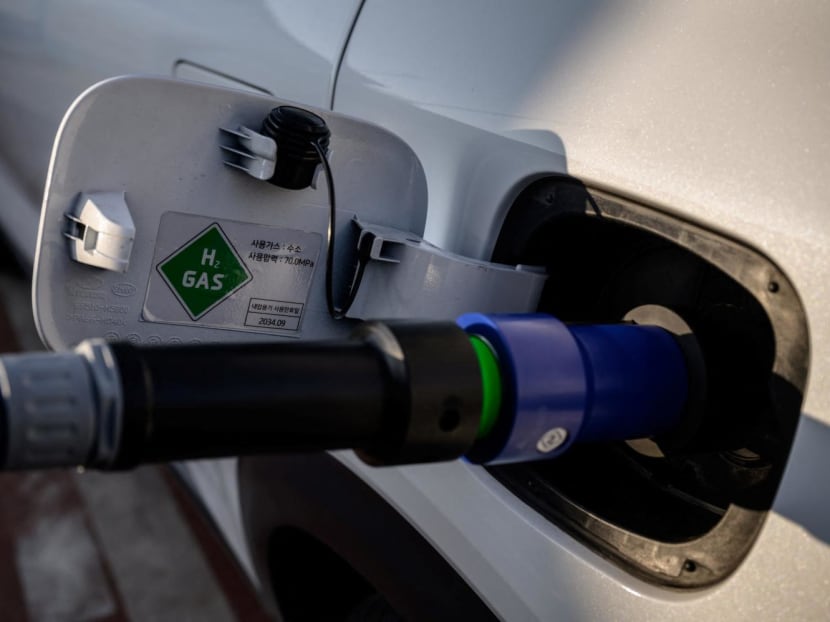Hydrogen to supply up to half of Singapore's power needs by 2050: Lawrence Wong
SINGAPORE — Singapore will be developing hydrogen as a major energy source to supply up to half of the country’s power needs by 2050, announced Deputy Prime Minister Lawrence Wong on Tuesday (Oct 25).

A car being refuelled at a station for hydrogen-powered vehicles in Seoul, South Korea.
- Singapore aims to supply up to 50 per cent of its power needs with hydrogen by 2050
- For a start, it will launch an expression of interest for commercial projects using ammonia — a derivative of hydrogen — for power generation
- This was announced by Deputy Prime Minister Lawrence Wong at the Singapore International Energy Week on Tuesday (Oct 25)
- Singapore will also scale up supply chains for low-carbon hydrogen, among other steps, to ensure it reaches its hydrogen goal
SINGAPORE — Singapore will be developing hydrogen as a major energy source to supply up to half of the country’s power needs by 2050, Deputy Prime Minister Lawrence Wong announced on Tuesday (Oct 25).
For a start, the Ministry of Trade and Industry (MTI) will be launching an expression of interest for a “small-scale commercial project on utilising low-carbon ammonia for power generation” among other things, Mr Wong said.
Ammonia is a derivative of hydrogen, which means it produces hydrogen.
Mr Wong, who is also Finance Minister, was speaking during the Singapore Energy Lecture at the Singapore International Energy Week held at the Marina Bay Sands, highlighting Singapore’s plan to adopt hydrogen as a major energy source — which he dubbed “Singapore’s National Hydrogen Strategy”.
Hydrogen is touted as a clean alternative to natural gas. This is because hydrogen produces water vapour as a waste product, while natural gas produces carbon dioxide among other waste products.
Natural gas now provides for more than 95 per cent of Singapore’s energy needs. Other sources include solar energy, with grid-connected solar panels generating 527 megawatt-peak as of the second quarter of 2021, the National Climate Change Secretariat's website states.
"If technology continues to advance, we foresee that hydrogen can supply up to half of our power needs by 2050, alongside domestic renewable energy sources and electricity imports," Mr Wong said.
However, the production and transport of hydrogen are not necessarily green unless producers adopt green energy sources.
For example, hydrogen can be produced by electrolysis of water — where electricity is used to split water into its various parts, such as hydrogen and oxygen — which can be energy intensive.
Singapore has signed various agreements with countries regarding green energy sources such as hydrogen — most recently on Oct 17 with Vietnam.
The memorandums of understanding signed between the two countries were about collaborating on energy, including developing low-carbon energy technologies such as hydrogen, ammonia and its related infrastructures.
PAVING THE WAY FOR HYDROGEN USE
Mr Wong noted that Singapore does not have many renewable energy options.
"We do not have the land for large solar or wind farms, or fast flowing rivers for hydro-electric power," he said.
"Nevertheless, we have managed to defy our natural constraints and made progress in reducing our greenhouse gas emissions."
This includes reducing the country's greenhouse gas emissions by 32 per cent below business-as-usual levels in 2020, double the earlier commitment of 16 per cent made in 2009.
Mr Wong noted that the technology and supply chains for low-carbon hydrogen are "still nascent", but global investments in the energy source have increased, backed by policies from countries to encourage this.
He also said that key technologies across the value chain are being trialled and are expected to become commercially available in the coming years.
"The world is now standing at an inflection point in global hydrogen development," he said.
"Given these positive developments, Singapore believes that low-carbon hydrogen has the potential to be the next frontier of our efforts to reduce Singapore's emissions."
He added that adopting low-carbon hydrogen here can reduce carbon emissions and also safeguard the country's energy security since it can be imported from diverse source countries.
It will also allow industries where hydrogen is used as a raw material — such as semiconductor plants and petrochemical processes — to produce sustainable products that could fetch a green premium.
In his speech, Mr Wong highlighted five key steps to prepare Singapore to use hydrogen for its decarbonisation efforts.
The country will be experimenting using advanced hydrogen technologies that are close to commercial readiness, such as the use of low-carbon ammonia for power generation.
“With this, Singaporeans may start to have access to electricity generated from low-carbon hydrogen from 2027. Through this project, we also hope to catalyse the development of ammonia supply chains for marine bunkering needs,” he said, adding that more details that will be released in the coming months.
Research and development work will be conducted to advance hydrogen technologies, including pumping another S$129 million into the Government's programme for low-carbon energy research.
This investment will be directed towards projects that can help Singapore import, handle and utilise hydrogen and its carriers safely and at scale.
Beyond that, the Government will be working closely with industry and international partners to create and scale up supply chains for low-carbon hydrogen.
"As a net importer of low-carbon hydrogen, it is essential that we have reliable and diversified supplies of hydrogen," he said.
"To this end, we aim to build a network of partnerships with like-minded countries and international organisations, to facilitate the establishment of these supply chains, even at this nascent stage."
One key focus area will be to develop frameworks and standards to certify the low-carbon origin of hydrogen imports that can be recognised across jurisdictions. This could be in the form of a guarantee of origin certification.
"This is crucial to providing hydrogen end-users and the international community the assurance that the hydrogen being used is indeed sustainable and can support our climate goals," he said.
Singapore will also develop its land, infrastructure and workforce to prepare for hydrogen adoption.
Describing this plan as a "rallying call" to industry and international partners to work with Singapore to use hydrogen as a decarbonisation pathway, Mr Wong said that the plan may be adjusted.
"We welcome new ideas and collaboration from all quarters to amplify our efforts and help us refine our approach, and we will also continue to adjust our strategy in line with technological and global supply chain developments."
In his speech, Mr Wong also announced that Singapore will aim to have new developments at Jurong Lake District, and the public sector to achieve net zero emissions by around 2045, among other things.
CORRECTION: An earlier version of this article stated that Singapore aims to supply half of its power needs with hydrogen by 2050. This is incorrect. It should be up to half of the country's power needs. We are sorry for the error.








